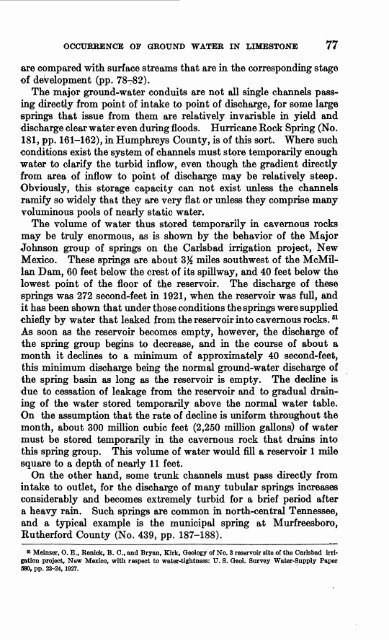GROUND WATER IN NORTH-CENTRAL TENNESSEE
GROUND WATER IN NORTH-CENTRAL TENNESSEE
GROUND WATER IN NORTH-CENTRAL TENNESSEE
Create successful ePaper yourself
Turn your PDF publications into a flip-book with our unique Google optimized e-Paper software.
OCCURRENCE OF <strong>GROUND</strong> <strong>WATER</strong> <strong>IN</strong> LIMESTONE 77<br />
are compared with surface streams that are in the corresponding stage<br />
of development (pp. 78-82).<br />
The major ground-water conduits are not all single channels pass<br />
ing directly from point of intake to point of discharge, for some large<br />
springs that issue from them are relatively invariable in yield and<br />
discharge clear water even during floods. Hurricane Rock Spring (No.<br />
181, pp. 161-162), in Humphreys County, is of this sort. Where such<br />
conditions exist the system of channels must store temporarily enough<br />
water to clarify the turbid inflow, even though the gradient directly<br />
from area of inflow to point of discharge may be relatively steep.<br />
Obviously, this storage capacity can not exist unless the channels<br />
ramify so widely that they are very flat or unless they comprise many<br />
voluminous pools of nearly static water.<br />
The volume of water thus stored temporarily in cavernous rocks<br />
may be truly enormous, as is shown by the behavior of the Major<br />
Johnson group of springs on the Carlsbad irrigation project, New<br />
Mexico. These springs are about 3% miles southwest of the McMil-<br />
lan Dam, 60 feet below the crest of its spillway, and 40 feet below the<br />
lowest point of the floor of the reservoir. The discharge of these<br />
springs was 272 second-feet in 1921, when the reservoir was full, and<br />
it has been shown that under those conditions the springs were supplied<br />
chiefly by water that leaked from the reservoir into cavernous rocks. 61<br />
As soon as the reservoir becomes empty, however, the discharge of<br />
the spring group begins to decrease, and in the course of about a<br />
month it declines to a minimum of approximately 40 second-feet,<br />
this minimum discharge being the normal ground-water discharge of<br />
the spring basin as long as the reservoir is empty. The decline is<br />
due to cessation of leakage from the reservoir and to gradual drain<br />
ing of the water stored temporarily above the normal water table.<br />
On the assumption that the rate of decline is uniform throughout the<br />
month, about 300 million cubic feet (2,250 million gallons) of water<br />
must be stored temporarily in the cavernous rock that drains into<br />
this spring group. This volume of water would fill a reservoir 1 mile<br />
square to a depth of nearly 11 feet.<br />
On the other hand, some trunk channels must pass directly from<br />
intake to outlet, for the discharge of many tubular springs increases<br />
considerably and becomes extremely turbid for a brief period after<br />
a heavy rain. Such springs are common in north-central Tennessee,<br />
and a typical example is the municipal spring at Murfreesboro,<br />
Rutherford County (No. 439, pp. 187-188).<br />
" Meinzer, O. E., Benick, B. O., and Bryan, Kirk, Geology of No. 3 reservoir site of the Carlsbad irri<br />
gation project, New Mexico, with respect to water-tightness: U. S. Qeol. Survey Water-Supply Paper<br />
580, pp. 23-24, 1927.

















